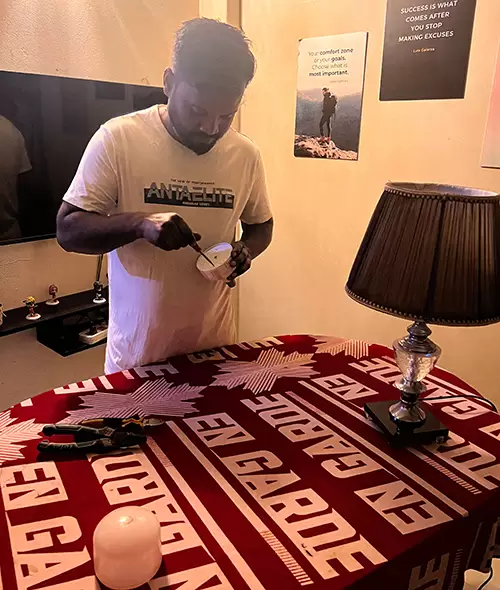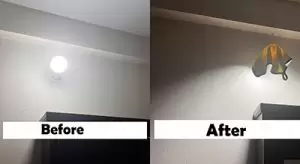There are several options for you to put over a light to dim it. First and the easiest way to do it is by using a permanent marker. Next, you can wrap the tape around it. While taping black tape is the most effective but frosted scotch tape is the quickest. Also, you can try LED stickers or light-dimming sheets to dim your lights.
To learn more about the methods in detail you’ll have to explore the whole content. There you’ll learn more about what not to put and some other methods. So keep on reading till the end.
Is It Safe to Cover LED Lights
It’s safe to cover LED lights only if you cover them with the proper tools. Covering LEDs with any wat tool is highly dangerous such as a wet towel. Water can conduct electricity and can easily damage the bulb.
Another thing is to avoid using fabric-like things such as t-shirts, fabric cloth, etc. It can trap heat and that causes overheating of the LEDs. As a result, it can sometimes cause a fire.
4 Things to put over a Light to Dim it
Now it’s time to explain the main segment. But before that a quick overview table is here for you. So, let’s look at the table first then read the extensive guide.
| Types | Methods |
| The ideal method | Light dimming sheets |
| The quickest method | Permanent Marker, Frosted Scotch Tape |
| The DIY method | Tissue and Tape |
| The cheapest method | Permanent Marker |
Table of Contents
Using Permanent Marker
The first thing, and probably the easiest thing is you can use a permanent marker. Well, not all markers will work here. Only the black and blue marker will help to dim the LED.
The thing here the marker helps with is it reduces the eye-burning brightness by quite a lot when used on the LED. However, it’ll still pass through a good amount of light. So, be careful about brighter LEDs.
Using Tapes
The next method here is quite popular; the tape method. Using different kinds of tapes you can block a good number of LEDs lights and dim them. Below I’ll be discussing them in detail.
Lithographer’s Tape: I wouldn’t say lithographer’s tape is highly effective but it works somehow. Generally, a lithographer’s tape brings a slight reddish tint to the LED color by blocking the eye-burning brightness.
It is one of the cheapest methods to dim your LED. A roll of lithographer’s tape shouldn’t cost you more than $5. And I am sure you will get a lifetime of LED-dimming stickers just from one roll.
Frosted Scotch Tape: If you’re looking for the quickest solution to dim a LED then I would recommend Frosted scotch tape though it’s not the most effective one. I think you already have semi-frosted office tape in your house. You can use them over the LEDs and they surely will block a good amount of light.
This method comes in use when you can’t sleep late at night or your baby wakes up suddenly and you are in a hurry to put them back to sleep again.
Using Black Tape: We know black color generally doesn’t reflect any light instead it absorbs the light. So, it’s a very good idea to wrap the LED using black tape. It will reduce the overall light output and dim it. Compared to other tapes black tape works the best.
Some Warnings for Using Tape
Though using tape is quite effective, it’s not highly recommended to use tape. It’s because tape can trap the temperature and can be the cause of overheating the LED. And sometimes due to overheating, there are possibilities of fire hazards.
Using Light-dimming Sheets/Stickers
If your LED light is too bright then using light-dimming sheets is highly effective.
The best thing about using light-dimming sheets is they are available in a variety of colors such as charcoal, blue, yellow, amber, red, green, clear, pink, tint, and others. So, according to how much light you need to reduce you can select different color light-dimming sheets.
Similar to LED dimming sheets you can also use LED-dimming stickers. The great thing is the stickers can block around 50-80% of LED lights. So, there are no ways to experience disrupted sleep or eye irritation.
Even if you want to block 100% of the light then it is also possible. You can pick the black edition stickers.
Pretty impressive idea, right? So, if you’re thinking of purchasing one then I can recommend LightDims Original Strength Dimming Sheets (Amazon).
Note: Keep in mind, the light-dimming sheets/stickers are more appropriate for low LED sources, such as a digital clock or for pc lights.
DIY Tissue And Tape Method
The better alternative to tape is using tissue and tape. Here the risk is less as well as the cost. It’s because tissue paper is lighter and won’t trap as much heat as tape. To do it I prefer using a dark color tissue because dark colors do the most dimming. Let’s see how to do it.
- First, get a tape roll and a tissue box.
- Now cut the tissue paper to size.
- Then slide or tape the tissue over the light.
And now you’re done. Quite easy and simple, right? Now let’s get into the next segment.
Some Other Ways to Dim Lights
So, if you don’t want to cover the light with something that’s the way to do it. Well, there are some different ways such as using PWM current regulators or by using resistors. However, it requires osm electrical knowledge. So, if you have basic electric knowledge then you can give them a try. Let’s learn about them in a bit more in detail.
Using PWM Current Regulator
Before learning how to use PWM let’s get some ideas about it. The full meaning of PWM is Pulse-width modulation. It’s a fantastic way for dimming lights because it gives you complete control over the power you get. This method is extremely effective and able to retain a sense of constancy in color.
To enable PWM dimming it’ll require a MOSFET switch in the driver electronics at the output of the DC power supply and a PWM controller. Besides, to appropriately control the current flowing to the lights, PWM sends pulses of current to your lights. Here the length of each pulse is adjusted.
Using Resistors
Using resistors is even an easier method. Dimming LEDs using resistors is also known as analog dimming.
Analog dimming refers to the process of adjusting the brightness of an LED light by simply adding resistors to the connection. So, here all you’ve to do is to calculate the power of the LED and then add different resistors of different ratings accordingly.
To help you in the calculation you can follow the law – P = I2 × R
Note: Here P is the power (In wattage), I is the current flow and R is the resistance
What Not to Put put over a light to dim it
You know what to put to dim a LED but it also needs to know what not to put over a light. Let’s see the list of things.
- Anything made of fabric is not recommended to put over lights because it can trap heat and your light can become extremely hot. Sometimes, there are chances to catch fire due to overheating.
- Anything wet and including a high amount of dust isn’t also recommended to put over light because dust and water can damage LEDs. So, never cover the light using a towel or cloth.
- Thick tapes aren’t also recommended to use to cover lights.
Verdict
I think now you’ve learned what to put over a light to dim it.
I’ve already added 5 ways to do it. However, in the end, I would suggest going for the light-dimming sheets to do it and avoid the tape method. As some thick tapes sometimes can affect the lights like a fabric does by overheating it.

I am Mark Braeden, a professional electrician based in California. With over a decade of experience in the electrical industry, I have launched this website with the aim of sharing my expertise and providing solutions to common lighting issues that can cause frustration for homeowners.
Whether you need help selecting the right bulb for your living room lamp or require guidance in installing LED strip lights, I am here to assist you.
But it’s not just about fixing problems. I’m also here to inspire you with all sorts of creative lighting ideas that can transform your home.






